Dian Fossey came to Rwanda to study gorillas in 1967, after the political climate in Congo became unwelcoming. She set up a campsite for research and named it Karisoke, as the center is called today. When Fossey was here, the mountain gorilla population was in decline. Most of the great ape species are, Bonilla said.
Through international cooperation and conservation, though, the mountain gorilla population is increasing. “This is a flagship species and shows it can be done,” Bonilla said.
Fossey wasn’t big on tourism, Bonilla said, but “it’s been huge for conservation. We could not protect gorillas without it.” (Fossey was murdered in the national park in 1985; the case remains unsolved.) Karisoke researchers keep close watch on the gorillas.
“We call it extreme conservation because we track every gorilla every day and know every gorilla by name,” Bonilla said. “It’s like taking care of your family, the individuals, not the population.” Some 100 Fossey Fund trackers, researchers and scientists follow gorillas in Volcanoes National Park. A GPS location of every gorilla is recorded daily along with other demographic data. The field researchers explore the area using a rotation system to see each gorilla each day.
A massive database started by Fossey logs their work.
“After 45 years, we still want to know more,” said Veronica Vecellio, Karisoke’s gorilla program coordinator.
Even after death, they study their bones.
“Gorillas are a very charismatic species,” said Bonilla, who’s from Guatemala but moved to Rwanda a few years ago with his family to manage gorilla protection programs. “They are beautiful to look at and just like us.”
We start hiking through farmland. It is a steep, steady climb for about 45 minutes.The path is clear, but our breath tightens as we take in the mountain air. Once we reach the park boundary, we scale a stone wall and the real adventure begins. We are in a bamboo rainforest, minutes from the gorillas.
The climb is not so steep now, but it’s through a muddy, cluttered forest floor. There are leaves, branches, roots and poo. It’s wet and hard to navigate.
The gloves I was told to wear suddenly make sense. I must steady myself to get by. After about 10 minutes, we meet the trackers who got an hour lead on us so they could find the gorillas.
At this point, we have to leave everything with the porters. Goodbye walking stick.It’s just me and the camera, which is bad, because here’s the really difficult part.
There is no path, only forest. The lead tracker uses a machete to forge a walkway, but really it’s an opening. Without the walking stick, this is tricky.
It’s a floor of muck. I am walking on it but unsure what is hard or soft. The mud is thick and envelops me. Twice my boots are nearly sucked away.Within minutes I smell the gorillas and then I see him — the silverback. He is planted at an opening in the forest like a guard at a house.
Today, the Dian Fossey Gorilla Fund organises memorable Rwanda gorilla tours to Volcanoes National park to see mountain gorillas in the wild and visit Dian Fossey tombs, nestled between the beautiful peaks of Vishoke and Karisimbi, also get an opportunity to interact with gorilla doctors and share stories about life of gorillas.


